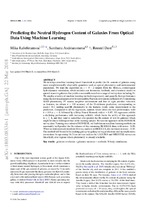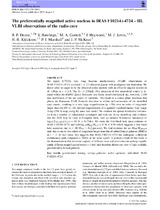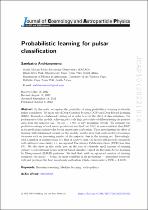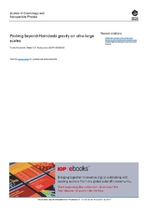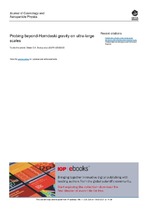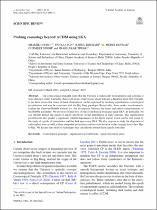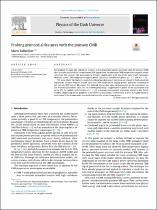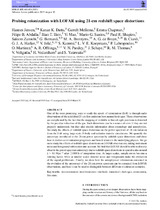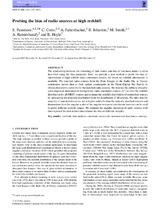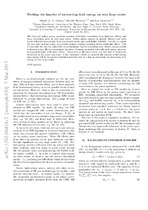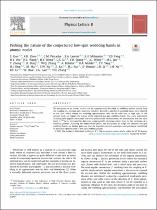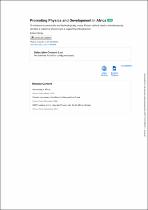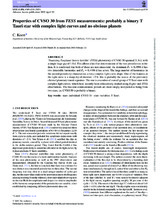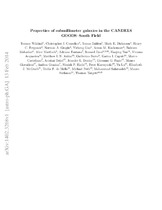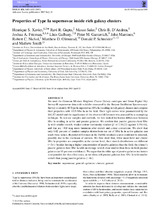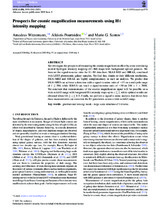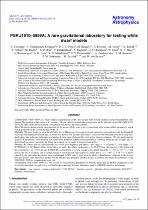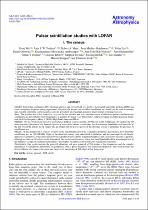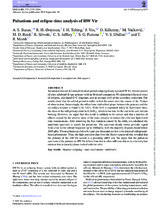Browsing Research Articles (Physics) by Title
Now showing items 383-402 of 510
-
Predicting the neutral hydrogen content of galaxies from optical data using machine learning
(Oxford University Press, 2018)We develop a machine learning-based framework to predict the Hi content of galaxies using more straightforwardly observable quantities such as optical photometry and environmental parameters. We train the algorithm on z ... -
The preferentially magnified active nucleus in IRAS F10214+4724 - III. VLBI observations of the radio core
(Oxford University Press, 2013)We report 1.7GHz very long baseline interferometry (VLBI) observations of IRAS F10214+4724, a lensed z = 2.3 obscured quasar with prodigious star formation. We detect what we argue to be the obscured active nucleus with ... -
Probabilistic learning for pulsar classification
(IOP Publishing, 2022)In this work, we explore the possibility of using probabilistic learning to identify pulsar candidates. We make use of Deep Gaussian Process (DGP) and Deep Kernel Learning (DKL). Trained on a balanced training set in ... -
Probing beyond-Horndeski gravity on ultra-large scales
(2020)The beyond-Horndeski gravity has recently been reformulated in the dark energy paradigm — which has been dubbed, Unified Dark Energy (UDE). The evolution equations for the given UDE appear to correspond to a non-conservative ... -
Probing beyond-Horndeski gravity on ultra-large scales
(IOP Publishing Ltd, 2020)The beyond-Horndeski gravity has recently been reformulated in the dark energy paradigm — which has been dubbed, Unified Dark Energy (UDE). The evolution equations for the given UDE appear to correspond to a non-conservative ... -
Probing Cosmology beyond ΛCDM using the SKA
(Indian Academy of Sciences, 2023)The cosmological principle states that the Universe is statistically homogeneous and isotropic at large distance scales. Currently, there exist many observations which indicate a departure from this principle. It has ... -
Probing primordial features with the primary CMB
(Elsevier, 2019)We propose to study the imprint of features in the primordial power spectrum with the primary CMB after the subtraction of the reconstructed ISW signal from the observed CMB temperature angular power spectrum. We consider ... -
Probing reionization with LOFAR (Low Frequency Array) using 21-cm redshift space distortions
(Oxford University Press, 2013)One of the most promising ways to study the epoch of reionization (EoR) is through radio observations of the redshifted 21-cm line emission from neutral hydrogen. These observations are complicated by the fact that the ... -
Probing the bias of radio sources at high redshift
(Oxford University Press, 2013)The relationship between the clustering of dark matter and that of luminous matter is often described using the bias parameter. Here, we provide a new method to probe the bias of intermediate-to-high-redshift radio ... -
Probing the imprint of interacting dark energy on very large scales
(American Physical Society, 2015)The observed galaxy power spectrum acquires relativistic corrections from light-cone effects, and these corrections grow on very large scales. Future galaxy surveys in optical, infrared and radio bands will probe increasingly ... -
Probing the nature of the conjectured low-spin wobbling bands in atomic nuclei
(Elsevier, 2022)The precession of an atomic nucleus can be approximately described as wobbling motion, arising from the coupling of a rotation and a harmonic vibration. Recently, a number of wobbling bands were reported at low spin, which ... -
Promoting physics and development in Africa
(American Institute of Physics, 2004)To excel in physics research in Africa is to conquer Mount Everest without the aid of additional oxygen. In a continent that lacks the infrastructure of research laboratories, technical support, and so forth, relatively ... -
Properties of CVSO 30 from TESS measurements: probably a binary T Tauri star with complex light curves and no obvious planets
(Oxford University Press, 2020)‘Transiting Exoplanet Survey Satellite’ (TESS) photometry of CVSO 30 spanned 21.8 d, with a single large gap of 1.1 d. This allows alias-free determination of the two periodicities in the data. It is confirmed that both ... -
Properties of submillimeter galaxies in the CANDELS GOODS-south field
(American Physical Society, 2014)We derive physical properties of 10 submillimeter galaxies located in the CANDELS coverage of the GOODS-S field. The galaxies were first identified as submillimeter sources with the LABOCA bolometer and subsequently targeted ... -
Properties of Type Ia supernovae inside rich galaxy clusters
(Oxford University Press, 2013)We used the Gaussian Mixture Brightest Cluster Galaxy catalogue and Sloan Digital Sky Survey-II supernovae data with redshifts measured by the Baryon Oscillation Spectroscopic Survey to identify 48 Type Ia supernovae ... -
Prospects for cosmic magnification measurements using H I intensity mapping
(Oxford University Press, 2020)We investigate the prospects of measuring the cosmic magnification effect by cross-correlating neutral hydrogen intensity mapping (H I IM) maps with background optical galaxies. We forecast the signal-to-noise ratio for ... -
PSRJ1910–5959A: A rare gravitational laboratory for testing white dwarf models
(EDP Sciences, 2023)Context. PSR J1910-5959A is a binary millisecond pulsar in a 0.837 day circular orbit around a helium white dwarf (HeWD) companion. The position of this pulsar is 6.3 arcmin (∼74 core radii) away from the optical centre ... -
Pulsar scintillation studies with LOFAR I. The census
(Hans Publishers, 2022)Interstellar scintillation (ISS) of pulsar emission can be used both as a probe of the ionized interstellar medium (IISM) and cause corruptions in pulsar timing experiments. Of particular interest are so-called scintillation ... -
Pulsars with NenuFAR: Backend and pipelines
(EDP Sciences, 2021)Context. NenuFAR (New extension in Nançay upgrading LOFAR) is a new radio telescope developed and built on the site of the Nançay Radio Observatory. It is designed to observe the largely unexplored frequency window from ... -
Pulsations and eclipse-time analysis of HWVir
(Oxford University Press, 2018)We analysed recent K2 data of the short-period eclipsing binary systemHWVir,which consists of a hot subdwarf-B type primary with an M-dwarf companion.We determined the mid-times of eclipses, calculated O–C diagrams, and ...

